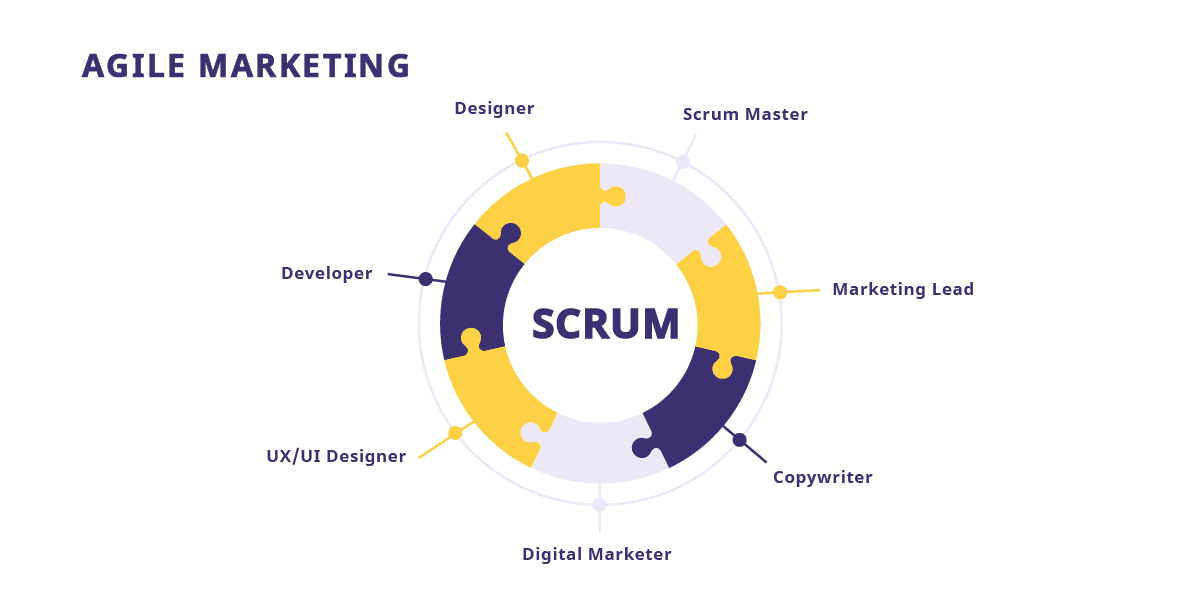Great agile marketers have one thing in common—a true team mentality; they’re not just a bunch of people forced to work together. Learn how to move from being an individual contributor to a true team player.
Are we really a team?
To truly embrace the level of collaboration and teamwork required for success in agile marketing, you must be able to visualize what team success looks like. In marketing, we’ve spent a long time working on individual tasks and being rated on job performance by how we perform solo.
An agile team is different, and it should feel a lot more like a sports team than a typical workgroup. Think about a high school football team during its homecoming game. All of the players are ligned on one big outcome—winning!

While everyone on the team has a primary position, they win or lose as a team. If Evan only cares about getting a touchdown and being the big star, he may not pass the ball to his teammates, and ultimately the team will lose because they aren’t working together.
An agile marketing team needs to understand what game they’re playing and how they can win. Then, everyone needs to work together to make that happen. The best agile teams I’ve worked with don’t always have fancy tools—what they do have is a clear understanding of what they’re trying to accomplish, and everyone offers to pitch in and help.
Creating a shared purpose
To build a high-performing team, you must have a shared purpose for working together. Often I see teams put together for the sake of checking a box, but everyone is working on individual tasks with no real understanding of the underlying goal and purpose of the team.
f this is the case, take some time with your team to create a team charter. The team vision creation needs to be done with the entire team, so find a time where you can get active participation from everyone.
A few examples of good team visions are:
“To reach physicians in the hospitals that we service with meaningful marketing messages”
“To provide engaging social media content to prospective customers that will make them fall in love with our brand”
The team vision should be something that’s not one-and-done, but truly creates the reason for your eam’s existence. Why are you a team? What do you strive to accomplish together? Keep the team’s vision somewhere visible to all team members and talk about it often, especially if you notice team members veering in another direction.
Your team should also decide how they will best work together and formulate a working agreement. Some things to cover are:
• How should we communicate with each other?
• What would make this team awesome?
• What things poison a team that we need to avoid?
Getting these answers is best done when all voices in the room can be heard. If you’re working remotely, use a collaborative sticky note or whiteboard tool to allow participants to submit ideas. I’ve facilitated several of these sessions with clients, and the best teams are empowered to do this without management intervention. The teams get really excited about defining their superpower!

My favorite team that did this was a team of non-marketers that was formed to clean up some technical problems. It’s work that most people would find really boring and not having a really big wow factor, but this team was passionate about its mission! “We’re the Blasters,” they told me as they enthusiastically whiteboarded out their purpose for existing.
Aligning on Big Hairy Audacious Goals
Big Hairy Audacious Goals (BHAGs) are a great way to align your team on what success looks like. While BHAGs don’t say everything that your team will be working on, it is helpful in aligning the team on what success looks like.
Aligning on BHAGs can be done quarterly or monthly, depending on the length of time your campaigns or projects are taking to complete. To align on BHAGs, a marketing owner, product owner or project owner would facilitate a working session with the team. This person should be able to clearly articulate one or two key things that the team will work on over the few months. This is what will align the team on what game they’re playing and how they can win.
The challenge that plagues agile marketing teams is we too often go from very high level goals, such as BHAGs or KPIs, to individual tasks.
This makes it really challenging for you, a member of an agile marketing team, to connect the dots. When we can come up with BHAGs, we can then go from the KPI measurement to something more actionable that everyone can get their heads around.
Breaking work into stories
While BHAGs are great at getting the team aligned around a big goal, the team then needs to break down the work into smaller, bite-sized chunks. By writing customer stories (also called user stories), the team can break the work down from something really big to the actual work they’ll do on the team.
Let’s take the example of promoting the online class offering, one of the sample BHAGs listed above. Your team needs to work together to understand what will go into this promotion. Hold a collaborative brainstorming session to think about all of the marketing involved such as e-mails, social posts, blog articles, webinars, etc.
Now, writing the work into stories gets us away from “mine vs. yours” and aligns the team on “ours”. We must all accomplish this story together to make it a success. To get stories written, do it collaboratively with your team.

